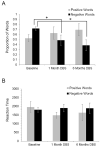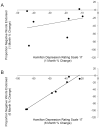Effects of subcallosal cingulate deep brain stimulation on negative self-bias in patients with treatment-resistant depression
- PMID: 25499035
- PMCID: PMC4366934
- DOI: 10.1016/j.brs.2014.11.010
Effects of subcallosal cingulate deep brain stimulation on negative self-bias in patients with treatment-resistant depression
Abstract
Background: The cognitive neuropsychological model states that antidepressant treatment alters emotional biases early in treatment, and after this initial change in emotional processing, environmental and social interactions allow for long-term/sustained changes in mood and behavior.
Objective: Changes in negative self-bias after chronic subcallosal cingulate (SCC) deep brain stimulation (DBS) were investigated with the hypothesis that treatment would lead to changes in emotional biases followed by changes in symptom severity.
Methods: Patients (N = 7) with treatment-resistant depression were assessed at three time points: pre-treatment; after one month stimulation; and after six months stimulation. The P1, P2, P3, and LPP (late positive potential) components of the event-related potential elicited by positive and negative trait adjectives were recorded in both a self-referential task and a general emotion recognition task.
Results: Results indicate that DBS reduced automatic attentional bias toward negative words early in treatment, as indexed by the P1 component, and controlled processing of negative words later in treatment, as indexed by the P3 component. Reduction in negative words endorsed as self-descriptive after six months DBS was associated with reduced depression severity after six months DBS. Change in emotional processing may be restricted to the self-referential task.
Conclusions: Together, these results suggest that the cognitive neuropsychological model, developed to explain the time-course of monoamine antidepressant treatment, may also be used as a framework to interpret the antidepressant effects of SCC DBS.
Keywords: Brodmann area 25; Electrical stimulation; Electroencephalography; Event-related potentials; Mood disorders; Subgenual cingulate.
Copyright © 2015 Elsevier Inc. All rights reserved.
Figures



References
-
- Beck A. The evolution of the cognitive model of depression and its neurobiological correlates. Am J Psychiatry. 2008;165:969–977. - PubMed
-
- Disner SG, Beevers CG, Haigh EA, Beck AT. Neural mechanisms of the cognitive model of depression. Nat Rev Neurosci. 2011;12:467–477. - PubMed
-
- Mathews A, MacLeod C. Cognitive vulnerability to emotional disorders. Annu Rev Clin Psychol. 2005;1:167–195. - PubMed
-
- Wisco BE. Depressive cognition: Self-reference and depth of processing. Clin Psychol Rev. 2009;29:382–392. - PubMed
Publication types
MeSH terms
Grants and funding
LinkOut - more resources
Full Text Sources
Other Literature Sources
Research Materials

